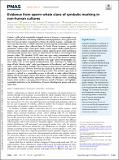Files in this item
Evidence from sperm whale clans of symbolic marking in non-human cultures
Item metadata
| dc.contributor.author | Hersh, Taylor A. | |
| dc.contributor.author | Gero, Shane | |
| dc.contributor.author | Rendell, Luke | |
| dc.contributor.author | Cantor, Maurício | |
| dc.contributor.author | Weilgart, Lindy | |
| dc.contributor.author | Amano, Masao | |
| dc.contributor.author | Dawson, Stephen M. | |
| dc.contributor.author | Slooten, Elisabeth | |
| dc.contributor.author | Johnson, Christopher M. | |
| dc.contributor.author | Kerr, Iain | |
| dc.contributor.author | Payne, Roger | |
| dc.contributor.author | Rogan, Andy | |
| dc.contributor.author | Antunes, Ricardo | |
| dc.contributor.author | Andrews, Olive | |
| dc.contributor.author | Ferguson, Elizabeth L. | |
| dc.contributor.author | Hom-Weaver, Cory Ann | |
| dc.contributor.author | Norris, Thomas F. | |
| dc.contributor.author | Barkley, Yvonne M. | |
| dc.contributor.author | Merkens, Karlina P. | |
| dc.contributor.author | Oleson, Erin M. | |
| dc.contributor.author | Doniol-Valcroze, Thomas | |
| dc.contributor.author | Pilkington, James F. | |
| dc.contributor.author | Gordon, Jonathan | |
| dc.contributor.author | Fernandes, Manuel | |
| dc.contributor.author | Guerra, Marta | |
| dc.contributor.author | Hickmott, Leigh | |
| dc.contributor.author | Whitehead, Hal | |
| dc.date.accessioned | 2023-03-08T00:42:13Z | |
| dc.date.available | 2023-03-08T00:42:13Z | |
| dc.date.issued | 2022-09-13 | |
| dc.identifier | 281524973 | |
| dc.identifier | 3da5403e-39f1-475f-863d-ea8b71c649b5 | |
| dc.identifier | 85137563120 | |
| dc.identifier.citation | Hersh , T A , Gero , S , Rendell , L , Cantor , M , Weilgart , L , Amano , M , Dawson , S M , Slooten , E , Johnson , C M , Kerr , I , Payne , R , Rogan , A , Antunes , R , Andrews , O , Ferguson , E L , Hom-Weaver , C A , Norris , T F , Barkley , Y M , Merkens , K P , Oleson , E M , Doniol-Valcroze , T , Pilkington , J F , Gordon , J , Fernandes , M , Guerra , M , Hickmott , L & Whitehead , H 2022 , ' Evidence from sperm whale clans of symbolic marking in non-human cultures ' , Proceedings of the National Academy of Sciences of the United States of America , vol. 119 , no. 37 , e2201692119 . https://doi.org/10.1073/pnas.2201692119 | en |
| dc.identifier.issn | 0027-8424 | |
| dc.identifier.other | Jisc: 608281 | |
| dc.identifier.other | ORCID: /0000-0002-1121-9142/work/120051671 | |
| dc.identifier.uri | https://hdl.handle.net/10023/27122 | |
| dc.description.abstract | Culture, a pillar of the remarkable ecological success of humans, is increasingly recognized as a powerful force structuring nonhuman animal populations. A key gap between these two types of culture is quantitative evidence of symbolic markers—seemingly arbitrary traits that function as reliable indicators of cultural group membership to conspecifics. Using acoustic data collected from 23 Pacific Ocean locations, we provide quantitative evidence that certain sperm whale acoustic signals exhibit spatial patterns consistent with a symbolic marker function. Culture segments sperm whale populations into behaviorally distinct clans, which are defined based on dialects of stereotyped click patterns (codas). We classified 23,429 codas into types using contaminated mixture models and hierarchically clustered coda repertoires into seven clans based on similarities in coda usage; then we evaluated whether coda usage varied with geographic distance within clans or with spatial overlap between clans. Similarities in within-clan usage of both “identity codas” (coda types diagnostic of clan identity) and “nonidentity codas” (coda types used by multiple clans) decrease as space between repertoire recording locations increases. However, between-clan similarity in identity, but not nonidentity, coda usage decreases as clan spatial overlap increases. This matches expectations if sympatry is related to a measurable pressure to diversify to make cultural divisions sharper, thereby providing evidence that identity codas function as symbolic markers of clan identity. Our study provides quantitative evidence of arbitrary traits, resembling human ethnic markers, conveying cultural identity outside of humans, and highlights remarkable similarities in the distributions of human ethnolinguistic groups and sperm whale clans. | |
| dc.format.extent | 8 | |
| dc.format.extent | 2459670 | |
| dc.language.iso | eng | |
| dc.relation.ispartof | Proceedings of the National Academy of Sciences of the United States of America | en |
| dc.subject | Culture | en |
| dc.subject | Symbolic markers | en |
| dc.subject | Bioacoustics | en |
| dc.subject | Distribution | en |
| dc.subject | Sperm whales | en |
| dc.subject | QH301 Biology | en |
| dc.subject | QL Zoology | en |
| dc.subject | DAS | en |
| dc.subject | MCC | en |
| dc.subject.lcc | QH301 | en |
| dc.subject.lcc | QL | en |
| dc.title | Evidence from sperm whale clans of symbolic marking in non-human cultures | en |
| dc.type | Journal article | en |
| dc.contributor.institution | University of St Andrews. School of Biology | en |
| dc.contributor.institution | University of St Andrews. Centre for Social Learning & Cognitive Evolution | en |
| dc.contributor.institution | University of St Andrews. Centre for Biological Diversity | en |
| dc.contributor.institution | University of St Andrews. Sea Mammal Research Unit | en |
| dc.contributor.institution | University of St Andrews. Institute of Behavioural and Neural Sciences | en |
| dc.contributor.institution | University of St Andrews. Bioacoustics group | en |
| dc.contributor.institution | University of St Andrews. Marine Alliance for Science & Technology Scotland | en |
| dc.identifier.doi | 10.1073/pnas.2201692119 | |
| dc.description.status | Peer reviewed | en |
| dc.date.embargoedUntil | 2023-03-08 |
This item appears in the following Collection(s)
Items in the St Andrews Research Repository are protected by copyright, with all rights reserved, unless otherwise indicated.

